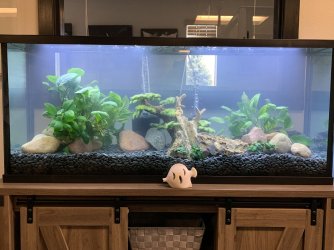@TwoTankAmin To me, the techniques don't matter. It's the goal.
Producing fish that could not survive in the wild because we like the pretty results of our work is just that. You can't argue it's natural selection because it's genetic manipulation by a conscious creator, the breeder. Someone has decided to play nature, gather the learning and skills and set out on a genetics experiment. If it is done by gene splicing, it manipulates a natural process (glo-fish breed true) as much as setting a line (balloon mollies breed true). Splicing genes is a means to an end, so is linebreeding. Neither produces fish that could last in nature. That's the bottom line.
I've had xanthic mutations occur in a killifish species I've kept for 20 or so years. I got them direct from Cameroon. I breed them in a group. The xanthic fish were a mutation, and the tank has no predators. I didn't remove them from a breeding group of 30+ fish, and their offspring if they had any never showed xanthism again. It's been about 12 years now since they appeared, and vanished. If I were a linebreeder, I would have manipulated the random mutation, removed the mutants, and gone through a very rigorous process of crossing parent to young, culling non xanthic fish etc. Mutations are random but linebreeding to set mutations is a skilled craft..
Whether you like it or not depends on opinion.
If we look at hybrids - they are crosses between distinct biological species. In the hobby, they include crosses between South American and North American fish, or fish that occur thousands of km apart. They are a different process than linebreeding. You don't make hybrids by selecting for traits. In swordtails, there are two species,
Xiphophorus monticola and
clemenciae whose DNA shows them to be ancient hybrids - a few tens of thousands of years back. They get mentioned because a cross like theirs, a sword and a platy, are uncommon species starters in nature, and they jump out as extra interesting within their species rich group. Hybridization is a driver in evolution, but most hybrids are dead ends.
Glofish are exactly what their species are as far as caring for them. If you're using them for a client's tank, check their temperature needs. I'll never keep them but I have heard they fade in cooler temperatures and you might want to check that. You said they'd be at 72f in your home tanks, but a show tank might need a heater. Offices often get cold at night too.



